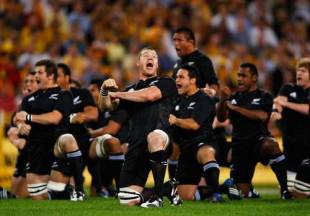|
Ireland v New Zealand
Williams embraces haka history
NZPA
November 13, 2008

Williams takes a leading role in the haka before a clash with Australia earlier this year
© Getty Images
Enlarge
It has not been unusual for the Pakeha boys to congregate at the back when the haka forms before an All Blacks Test - Ali Williams, however, is an noticeable exception to the rule. The lock, who is as proud of his Scottish heritage as his birthplace, has consciously adopted a central role when the pre-match ritual is assembled, or more accurately a forward position. From there, Williams will throw his headgear provocatively toward the opposition -- presumably because he has to move closer to their lines to retrieve it -- and then perform Ka Mate or Kapa O Pango with a determination normally associated with an Inga Tuigamala, Jonah Lomu or, more recently, Byron Kelleher. They, too, preferred to place themselves slightly closer to the opposition, a little detached from their team-mates, when issuing the challenge. And as his test career has progressed, Williams admitted he also felt comfortable being rather conspicuous by his actions. "Originally I wasn't scared of it, but I didn't really buy into it,' Williams said. But since making his test debut at Twickenham in 2002, the 58-cap second rower said he has gained a greater appreciation for one of the iconic images associated with New Zealand rugby, and his rendition has intensified accordingly. "I do get quite emotional about the whole thing. Over time we've educated ourselves about what it is, the purpose of it and obviously we've bought into what it means for the team. It's just evolved really," he said, ahead of the All Blacks test against Ireland at Croke Park on Saturday. Naturally the haka is also a motivational tool, an outlet to get the blood pumping -- not that there is any shortage of emotionally charged elements to quicken the pulse when playing in the northern hemisphere. The All Blacks' visit to Murrayfield last weekend, was a case in point. The stadium lights were dimmed as teams walked on to the pitch, they then reignited before a band then piped half of the Scottish anthem Flower of Scotland. A crowd of 51,000 then sang the last verse unaccompanied. It was a moving experience and one sure to be repeated at Croke Park, the Millennium Stadium and Twickenham, let alone Limerick's Thormond Park next Wednesday where Munster commemorate the 30th anniversary of their 12-0 victory over the 1978 All Blacks. All promise to be experiences to savour for All Blacks, young and old. "When you're at home you tell people it's different being an All Black in the northern hemisphere -- it's the emotion and history these places have," Williams said. "My parents led me into it before I was an All Black. Some of the things they do here are just amazing -- the national anthems are just another level, the crowd support, the passion the people have is huge." A player could be overawed, but Williams' advice was to embrace the atmosphere. "Sometimes you get into a bubble when you're playing rugby. Every now and then you have to get out of that bubble, step back and enjoy it." © Scrum.com
|
Live Sports
Communication error please reload the page.
-
Football
-
Cricket
-
Rugby
-
- Days
- Hrs
- Mins
- Secs
F1 - Abu Dhabi GP
Abu Dhabi Grand Prix December 11-131. Max Verstappen ()
2. Valtteri Bottas (Mercedes)
3. Lewis Hamilton (Mercedes)
4. Alexander Albon ()
5. Lando Norris ()
6. Carlos Sainz Jr ()
-
ESPNOtherLive >>
Snooker - China Open
Tennis - Miami Open

